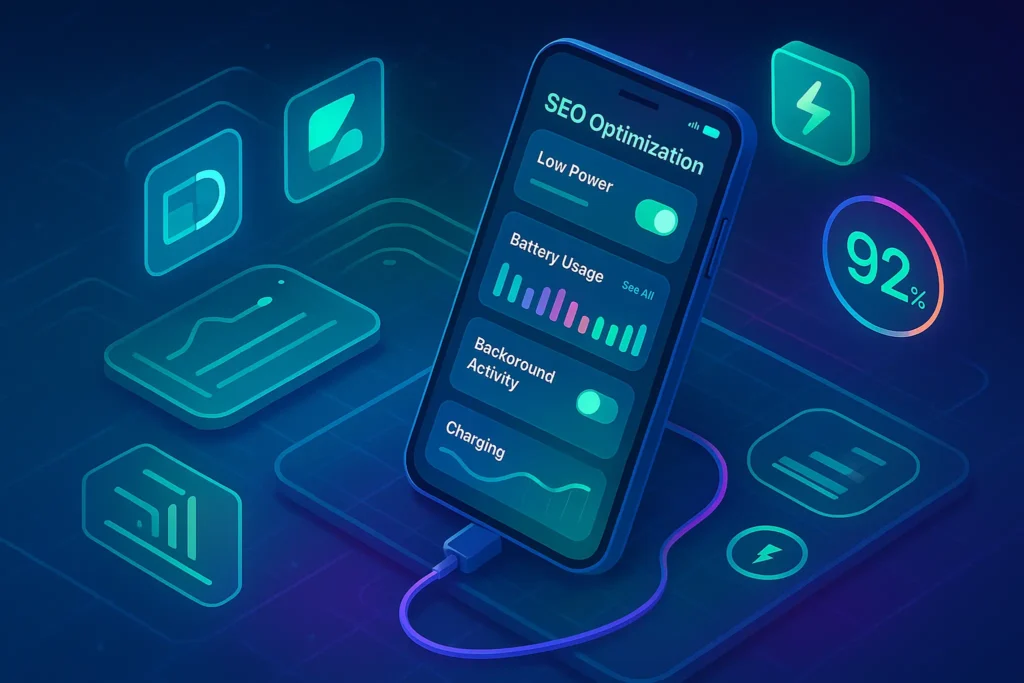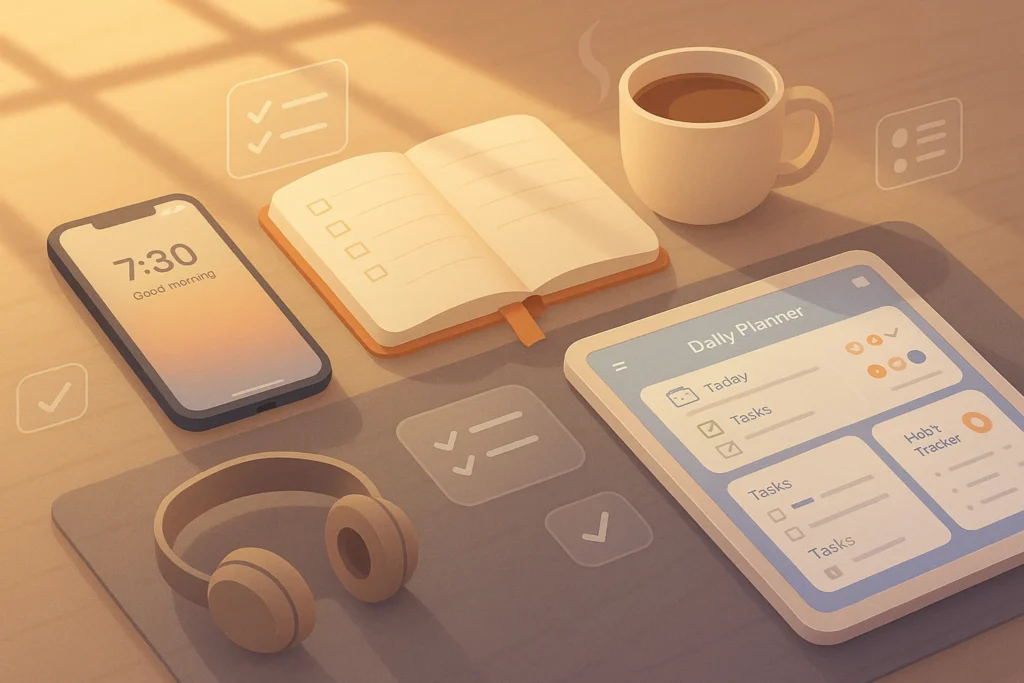🔋 Introduction: Battery Is Still Your Phone’s Weakest Link
No matter how powerful your smartphone is, a dying battery can turn it into a useless slab of glass. In 2025, most devices pack performance comparable to laptops—but battery life still hasn’t caught up. That’s why optimizing how your phone uses (and charges) power is one of the most valuable things you can do as a user.
This guide isn’t about basic “lower brightness” tips. Instead, we’ll dive into actionable, lesser-known strategies to help you squeeze every drop of life from your smartphone—without turning it into a brick.
🔧 1. Background Activity: The Silent Battery Killer
Even when your screen is off, dozens of apps might still be burning through your battery. Social media, GPS apps, messaging platforms, and even calendar sync services are notorious for draining power in the background.
On Android, navigate to Settings → Battery → App usage since last full charge. This shows you which apps are consuming the most power—even if you haven’t opened them all day. Apps like Facebook, Instagram, and Snapchat are frequent culprits.
iOS users can head to Settings → Battery to view the last 24 or 10 days of activity. Disabling Background App Refresh for non-essential apps often reduces drain dramatically.
Try placing GPS-based apps like Uber or Maps into “Only While Using” mode. And if you’re not using Bluetooth or Auto-Sync (like calendar or email), disable them—these features keep your phone awake more than you realize.
📌 If you’re a creator managing multiple devices, check out Best Smartphone Accessories for Content Creators for tools that minimize constant device switching—another source of power drain.
🛠️ 2. Native Optimization Settings You Probably Forgot Exist
Most modern smartphones come with built-in battery optimization modes—but they’re rarely used to their full potential.
Android’s Battery Saver Mode not only reduces background activity but also limits animations, CPU usage, and sync processes. On Pixel and Samsung devices, you can automate this based on schedule or battery percentage.
Adaptive Brightness is another underutilized feature. While manual control may seem better, adaptive brightness learns your habits over time, adjusting based on context and light exposure—offering a smarter tradeoff between visibility and consumption.
On iPhones, Low Power Mode does more than just dim the screen—it disables mail fetch, visual effects, and some background tasks. You can also create an automation via Shortcuts app to trigger Low Power Mode under specific conditions like time of day or when a certain app is opened.
🛠 Don’t forget: putting unused apps to sleep manually helps tremendously. On Android, long-press the app → App Info → Battery → select “Restricted.”
This level of control, especially on Android 12 and above, can drastically extend battery life—without needing third-party apps.
📬 Want More Smart Tech & Productivity Hacks?
Subscribe to our free NerdChips newsletter and get weekly insights on mobile optimization, future tech, AI tools, and practical workflows. No fluff. Just the smartest ways to work better and charge less.
🔒 No spam. Just pure tech intelligence delivered to your inbox.
⚡ 3. Smart Charging Habits (Stop Killing Your Battery Overnight)
How and when you charge your phone matters as much as how often. Many users still plug in their phones overnight, letting them sit at 100% for hours. This creates long-term stress on lithium-ion batteries.
Instead, aim to keep your phone battery between 20% and 80% most of the time. Charging all the way to 100% occasionally is okay—but doing it daily accelerates wear.
Many phones now offer Optimized Charging. On iPhones, this feature slows down charging past 80% until you need it—based on your routine. Android phones like OnePlus, Samsung, and Google offer similar options under “Battery Care” or “Protect Battery” features.
If you charge overnight, consider using a slow charger or wireless pad rather than a fast-charging brick. Fast charging is excellent when you’re in a hurry—but using it daily, especially at night, heats up your battery and shortens lifespan.
Looking for gear that helps you charge smart? Don’t miss our list of Top 10 Must-Have Gadgets for Productivity—where we feature smart chargers with heat control and battery-safe charging curves.
🧪 4. Battery Calibration & Health Check: Get Accurate Readings Again
Ever notice your phone suddenly drops from 40% to 10%? That’s not just your imagination—it’s likely a calibration issue.
Over time, battery monitoring software can become inaccurate. To recalibrate:
-
Drain your battery completely until it shuts off.
-
Leave it off for 30–60 minutes.
-
Charge it uninterrupted to 100%.
-
Keep it plugged in for another hour before unplugging.
This helps the system re-learn the actual capacity and improve reporting accuracy.
For Android, apps like AccuBattery or Battery Guru provide health estimation, charge cycles, and temperature trends. On iPhones, check Settings → Battery → Battery Health & Charging for metrics like Maximum Capacity and Peak Performance Capability.
Keeping an eye on your battery health is as crucial as any optimization setting. And if you’re running older devices or refurbished models, this step is non-negotiable.
🕳️ 5. Hidden Battery Drains You’re Not Paying Attention To
Even with good habits in place, many users overlook features quietly draining their phones in the background. Things like Bluetooth, Wi-Fi scanning, location services, and auto-syncing cloud apps often run persistently—whether or not you’re actively using them.
One of the biggest culprits? Always-on voice assistants like Siri or Google Assistant. These features constantly listen for wake words (“Hey Siri,” “OK Google”), which uses microphone access and keeps parts of your system awake.
Another overlooked battery drain is high refresh rate displays. Many phones today default to 90Hz or 120Hz—great for smooth scrolling, terrible for battery life. Most phones now let you toggle between standard (60Hz) and high refresh rates either manually or automatically. If you’re reading or watching static content, 60Hz is enough.
Also, consider turning off Auto-Sync for apps like Google Photos, Dropbox, or OneDrive unless you’re on Wi-Fi or actively uploading. Auto-backup services continuously use data and CPU resources in the background.
Bonus tip: disable network scanning under advanced Wi-Fi settings. This feature keeps searching for stronger connections and uses power even when Wi-Fi is off.
And if you use widgets that require live updates (weather, stocks, news), limit them to just one or two. Each one forces your phone to “wake up” periodically.
🔌 6. Bonus: Accessories & Tools That Actually Help
Sometimes, the right hardware can give your phone a real edge in power efficiency. Here are a few battery-related accessories worth adding to your toolkit:
-
Smart Power Banks: Newer models include trickle-charging modes that prevent overheating and overcharging.
-
USB-C Voltage Meters: These inexpensive tools can show how much current your charger delivers—helpful for identifying fake or underpowered bricks.
-
Temperature-Controlled Charging Cables: Some advanced cables monitor heat and modulate current accordingly.
-
Portable Battery Health Testers: For tech-savvy users, testers like the ZKE Tech series can measure actual mAh capacity of used batteries.
You can even combine your phone with tools featured in Best Tech Gadgets Under $50 to build a portable, safe charging setup for travel or daily use.
📱 Device-Specific Battery Behavior: iOS vs Android
While most battery optimization strategies apply across platforms, there are key differences between how Android and iOS handle power management—and knowing them can help you get more out of your specific device.
On Android, you get more granular control over what apps do in the background. You can restrict battery usage per app, toggle adaptive battery features, and even disable CPU-heavy services per app. For example, you can fully restrict Instagram from running in the background while still allowing WhatsApp notifications.
On iPhones, system-level optimization is more opaque—but incredibly smart. iOS uses machine learning to predict your charging habits and automatically delays charging past 80% until you need it (Optimized Battery Charging). However, background refresh must be manually disabled per app via Settings → General → Background App Refresh—there’s no global toggle.
Also, Android allows deeper customizations like battery profiles, app sleep modes, and third-party calibration apps, while Apple keeps things more locked down, prioritizing long-term consistency.
If you switch between ecosystems or manage both iOS and Android devices (like many creators do), it’s important to tailor your habits to each platform’s strengths.
🔍 Charging Myths That Deserve to Die
Despite massive improvements in lithium-ion technology, many users still follow outdated—or outright harmful—charging habits. Let’s debunk a few of the most common:
“You should always charge to 100%.”
Not true. Regularly charging to 100% puts your battery in high-voltage states, which accelerates chemical wear. Instead, aim for partial charges between 20–80%.
“Fast charging always damages your battery.”
Partially false. Occasional fast charging is fine and built into modern devices. The real problem is heat. If you fast charge in a hot environment or while gaming, battery degradation increases.
“Using your phone while it charges will damage it.”
Also misleading. Using your phone during charging is fine, as long as the temperature stays reasonable. Avoid heavy 3D gaming or 4K streaming during fast charging sessions to prevent overheating.
“You should fully drain your battery before charging.”
This myth came from the nickel-cadmium battery era. Today’s lithium-ion batteries prefer partial cycles. Fully draining regularly can actually shorten battery life.
Clearing up these myths helps users make smarter, evidence-based decisions—and avoid behaviors that silently reduce battery performance over time.
📊 Battery Longevity Strategy: Thinking Beyond Daily Drain
Most battery advice focuses on getting through the day. But what about preserving battery health across months or even years?
If you plan to keep your phone for 2+ years—or resell it with decent battery capacity—here’s what matters most:
-
Avoid sustained high temperatures. Leaving your phone charging in a hot car or on top of a laptop vent can permanently reduce battery capacity.
-
Charge slowly when possible. Use slow-charging pads overnight instead of 30W+ bricks, unless you’re in a rush.
-
Use battery-health monitoring tools. On Android, apps like AccuBattery let you set charge targets (like 85%) and track real capacity over time. On iPhones, Battery Health stats are built into Settings.
-
Limit high-drain usage during charging. Streaming, hotspot usage, and gaming all increase heat. Wait till the charge completes—or use low-power modes when plugged in.
You can also set a monthly “Battery Health Check” reminder to:
-
Check for software updates (many include thermal/battery optimizations)
-
Calibrate once every few months
-
Review app-level battery consumption patterns
Think of it as preventive care for your most-used device. Battery health is like stamina: it fades slowly—but managing it now pays dividends later.
📘 Real-Life Scenario: Surviving a Full Day as a Power User
Let’s say you’re traveling, working remotely, or attending an all-day conference—and you don’t want to carry a charger or power bank.
You’ll likely be using Bluetooth (earbuds), hotspot, maps, camera, and productivity apps—all battery-hungry. Here’s what a real-world optimization setup could look like:
-
Start your day in Low Power Mode, even at 100%—don’t wait until you’re at 20%. This extends idle time and background processing limits from the beginning.
-
Manually reduce brightness to 50–60%, and turn off auto-brightness to avoid spikes.
-
Disable auto-sync for email, and refresh manually every few hours.
-
Use offline maps where possible, and set apps like Spotify to offline mode.
-
Close all apps running in the background after each major use (especially navigation and social media).
-
Keep Bluetooth active only when your earbuds are in use—not during idle.
This isn’t theory—it’s a practical setup that could easily get you through a 14-hour mobile workday. It’s all about planning ahead and knowing how to manually control your power flow.
🧠 Nerd Verdict
Battery life isn’t just about saving a few percentage points—it’s about keeping your smartphone reliable, fast, and long-lasting over the months (and years) you own it. From smart charging habits and OS-level tweaks to calibration tricks and overlooked drains, there are more ways than ever to make your device last longer per charge—and per year.
In a world where everything from navigation to productivity depends on your phone staying alive, treating your battery well is no longer optional. It’s a core part of owning your tech like a pro.
❓ FAQ: Nerds Ask, We Answer
💬 Would You Bite?
Are you just letting your phone burn through battery every day—or are you ready to take control with smarter habits and powerful tools?
Let us know in the comments! 👇



